Philips Bundle
How Does the Philips Company Thrive in the Healthcare Tech Arena?
Philips, a titan in health technology, has undergone a remarkable transformation, evolving from a diverse conglomerate to a focused powerhouse. Its strategic shift is evident in its impressive Q1 2024 performance, showcasing robust growth in key segments. This evolution underscores Philips' significant impact on healthcare, offering vital solutions that enhance patient care and operational efficiency.
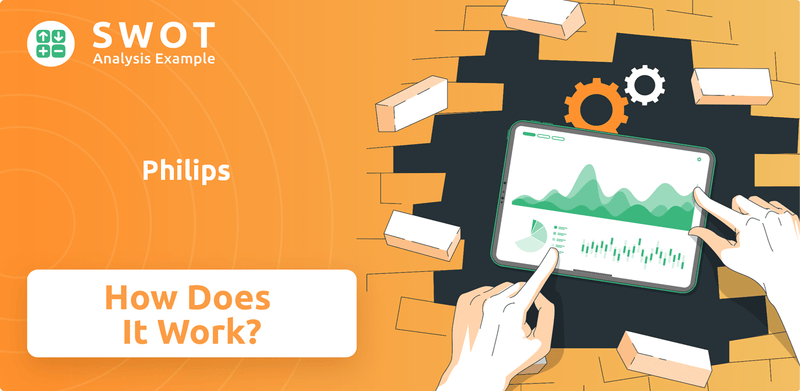
Delving into Philips SWOT Analysis is key to grasping its operational intricacies. Understanding the Philips business model and Philips operations is essential for investors, customers, and industry analysts alike. This exploration will illuminate how Philips company generates revenue, navigates market dynamics, and continues to innovate within the dynamic healthcare sector, offering insights into its financial health and future prospects.
What Are the Key Operations Driving Philips’s Success?
The core operations and value proposition of the company center on integrated health technology solutions designed to enhance people's health and well-being. The company focuses on serving professional healthcare providers, including hospitals and clinics, as well as individual consumers. Key offerings include medical diagnostic imaging systems, patient monitoring systems, and healthcare informatics solutions.
In its personal health segment, the company offers products like electric toothbrushes, shavers, and mother and child care products, all designed to promote healthy living and prevention. These offerings are supported by advanced technology development, precision manufacturing, and a robust global supply chain. The company invests significantly in research and development to innovate new diagnostic and therapeutic solutions.
The value proposition is centered on delivering meaningful innovation that translates into improved clinical outcomes, enhanced patient experiences, and greater healthcare productivity. Its integrated solutions, such as the Azurion image-guided therapy platform, allow for minimally invasive procedures, reducing recovery times and improving patient safety. Strategic partnerships with healthcare systems and research institutions further enhance its capabilities and market differentiation.
The company's product range includes medical diagnostic imaging systems (MRI, CT, Ultrasound), patient monitoring systems, and healthcare informatics solutions. It also offers personal health products such as electric toothbrushes, shavers, and mother and child care items. These products and services are designed to meet the needs of both healthcare professionals and individual consumers.
Operational processes are rooted in advanced technology development, precision manufacturing, and a global supply chain. The company invests heavily in research and development for innovation. Manufacturing facilities are strategically located worldwide. Supply chain management is critical, especially in navigating global disruptions. The company's focus on these areas supports its ability to deliver high-quality products and services.
The value proposition centers on delivering meaningful innovation that improves clinical outcomes, patient experiences, and healthcare productivity. Integrated solutions, such as the Azurion platform, enable minimally invasive procedures. The company's deep clinical expertise and technological prowess enable the development of advanced, user-friendly solutions. Strategic partnerships enhance capabilities and market differentiation.
The company's commitment to innovation is evident through its continuous introduction of AI-powered platforms and integrated care pathways. It invests significantly in research and development to create new diagnostic and therapeutic solutions. This focus allows the company to stay at the forefront of technological advancements in healthcare.
The company's business model is built on a foundation of healthcare technology, personal health products, and innovation. The company's operations are global, with manufacturing and research facilities located worldwide. The company's financial performance reflects its strategic focus on healthcare and personal health, with a commitment to sustainable practices.
- The company's revenue in 2023 was approximately €18.2 billion.
- Research and development expenses in 2023 were around €1.1 billion, demonstrating a strong commitment to innovation.
- The company has a significant presence in the medical technology market, with a focus on improving patient outcomes.
- The company's growth strategy, as discussed in Growth Strategy of Philips, emphasizes innovation and strategic partnerships.
Philips SWOT Analysis
- Complete SWOT Breakdown
- Fully Customizable
- Editable in Excel & Word
- Professional Formatting
- Investor-Ready Format
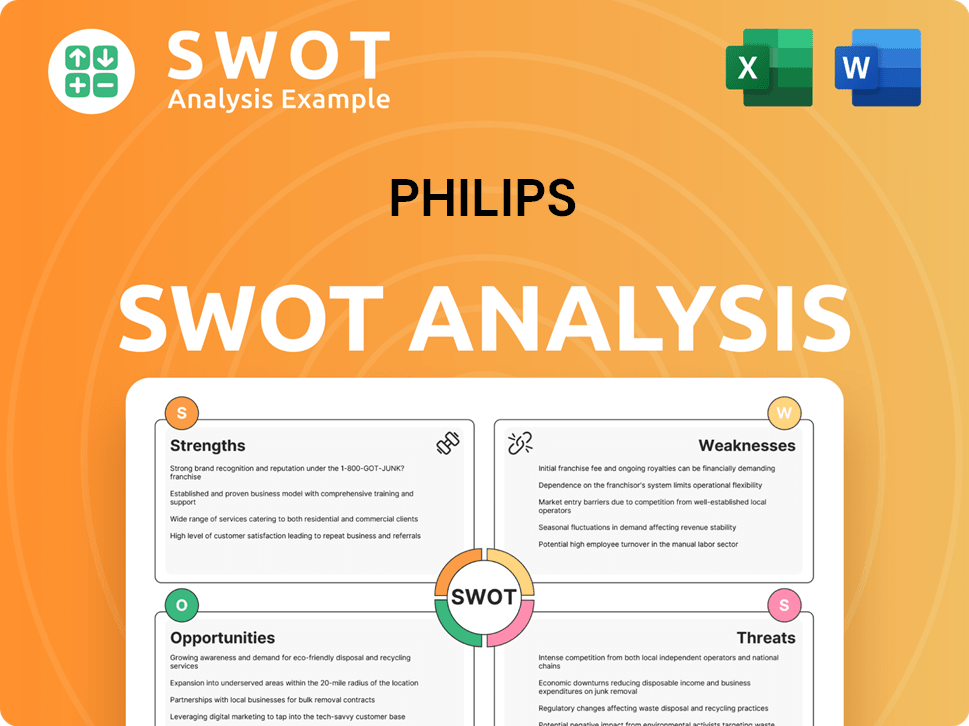
How Does Philips Make Money?
The Philips company generates revenue primarily through the sale of its health technology products and related services. Its business model is centered around three main segments: Diagnosis & Treatment, Connected Care, and Personal Health. The company's financial performance reflects its strategic focus on healthcare innovation and integrated solutions.
In the first quarter of 2024, Philips reported total sales of €4.17 billion. The Diagnosis & Treatment segment showed strong performance, with comparable sales growth of 9%. This growth was driven by double-digit growth in Diagnostic Imaging and Image-Guided Therapy. The Connected Care segment also contributed positively, showing a 2% increase in comparable sales during the same period.
Personal Health provides a stable revenue base through the sale of consumer health products. The company continues to evolve its monetization strategies, focusing on recurring revenue streams and value-based care models to align with customer needs and healthcare trends. For more details on the company's strategic direction, you can read about the Growth Strategy of Philips.
Philips employs several monetization strategies to generate revenue. These strategies include product sales, services, and bundled offerings. The company's approach is evolving to include value-based care models.
- Product Sales: Direct sales to hospitals and healthcare providers, and retail sales for personal health products.
- Services: Maintenance, repairs, and software subscriptions for healthcare informatics platforms.
- Bundled Service Offerings: Equipment sales packaged with long-term service agreements.
- Value-Based Care: Compensation based on achieved patient outcomes.
Philips PESTLE Analysis
- Covers All 6 PESTLE Categories
- No Research Needed – Save Hours of Work
- Built by Experts, Trusted by Consultants
- Instant Download, Ready to Use
- 100% Editable, Fully Customizable
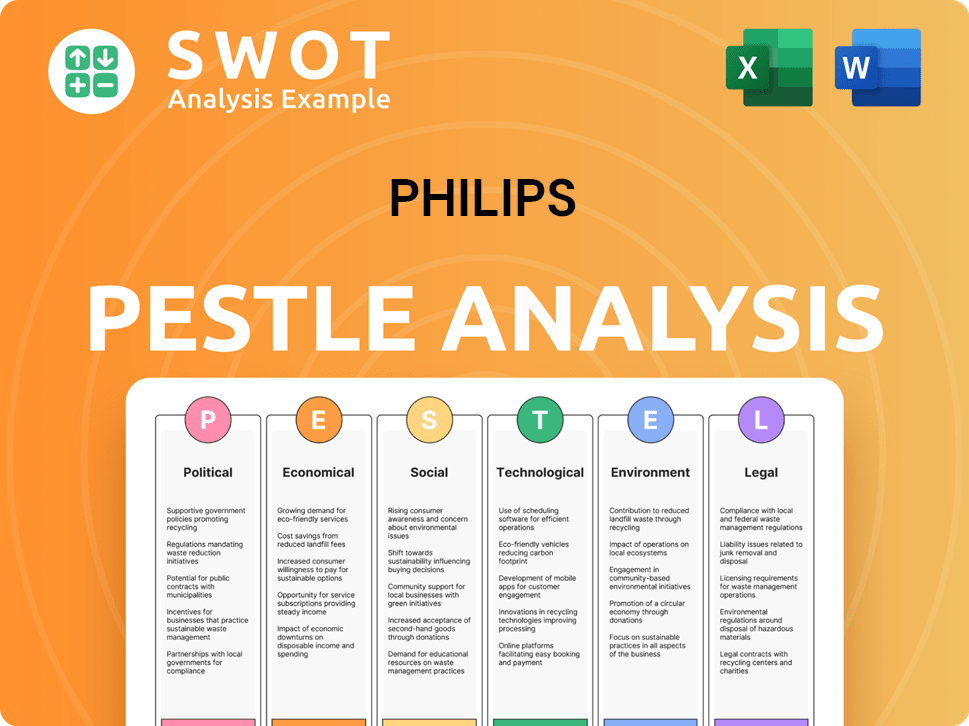
Which Strategic Decisions Have Shaped Philips’s Business Model?
The journey of the Philips company has been marked by significant milestones and strategic shifts. A pivotal move was the divestment of its lighting business in 2016, which refocused the company entirely on health technology. This strategic realignment allowed for greater investment in its core healthcare segments, streamlining operations and enhancing its competitive position.
More recently, Philips has faced operational and market challenges, particularly with the recall of certain Sleep & Respiratory Care devices. This issue resulted in a substantial provision of €575 million in Q1 2024, impacting profitability and necessitating extensive remediation efforts. Despite these setbacks, the company has shown resilience, with comparable sales growth in Q1 2024 indicating a partial recovery and strong performance in other segments.
In response to these challenges, Philips has prioritized improving supply chain reliability and quality management. The company aims to enhance product availability and customer trust. Its competitive advantages include strong brand recognition, technological leadership in medical imaging, and a global distribution network. For more details on the company's marketing strategies, see this article: Marketing Strategy of Philips.
Key milestones include the 2016 divestiture of the lighting business, which streamlined operations. The company's focus shifted entirely to health technology. Recent challenges include the recall of Sleep & Respiratory Care devices, impacting financial performance.
Strategic moves involve focusing on health technology and investing in R&D. The company is expanding its presence in growth markets. It emphasizes integrated care pathways and connected health solutions to deliver value.
The company benefits from strong brand recognition and technological leadership. It leverages economies of scale in manufacturing and global distribution. Extensive partnerships with healthcare providers strengthen its market position.
In Q1 2024, Philips reported a provision of €575 million. Comparable sales growth showed a partial recovery. The company is focused on improving supply chain reliability and quality management.
The Philips company maintains a competitive edge through several key advantages. These include strong brand recognition, technological leadership, and a global distribution network.
- Strong Brand Recognition: Decades of building trust among healthcare professionals and consumers.
- Technological Leadership: Continuous innovation in medical imaging and image-guided therapy.
- Global Distribution: Efficiently serving diverse markets.
- Extensive Partnerships: Collaborations with healthcare providers and research institutions.
Philips Business Model Canvas
- Complete 9-Block Business Model Canvas
- Effortlessly Communicate Your Business Strategy
- Investor-Ready BMC Format
- 100% Editable and Customizable
- Clear and Structured Layout
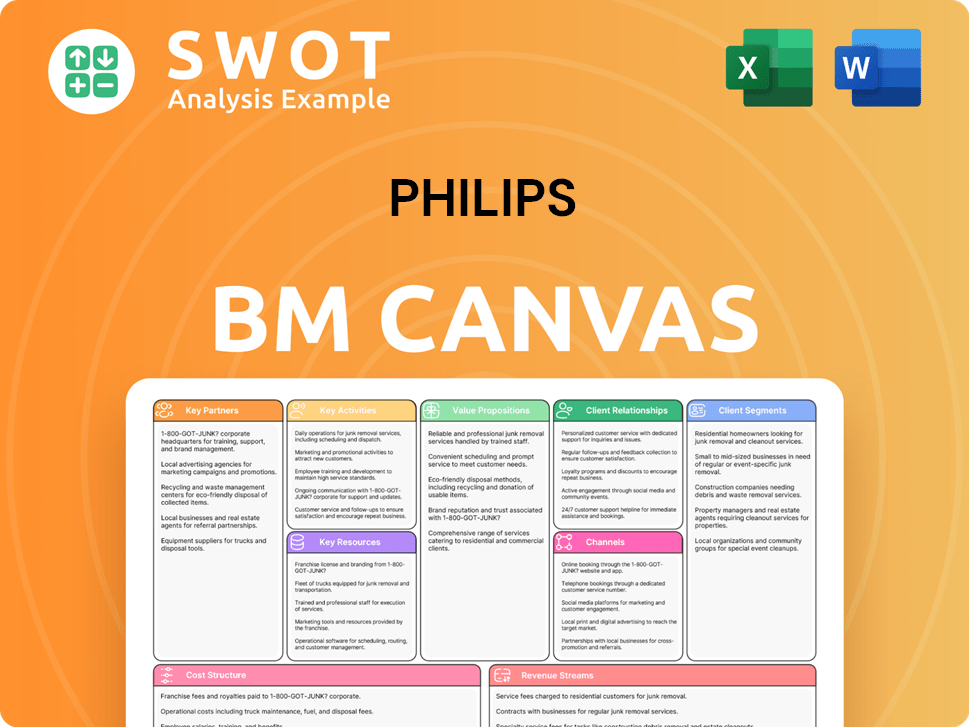
How Is Philips Positioning Itself for Continued Success?
The Philips company holds a prominent position in the global health technology sector, competing with major players like Siemens Healthineers and GE HealthCare. The company's strong market share in segments such as diagnostic imaging and patient monitoring is supported by its brand recognition, extensive product portfolio, and global service network. Customer loyalty is generally high due to the reliability and advanced capabilities of its medical equipment and integrated solutions.
Despite its robust position, the Philips company faces several risks. These include regulatory changes in the medical device sector and the emergence of new competitors, such as agile startups focusing on digital health and AI. Technological disruption and supply chain volatility also pose challenges. Addressing these challenges is crucial for the long-term success of Philips operations.
Philips maintains a significant market share in diagnostic imaging and patient monitoring. The company's global reach allows it to tap into diverse healthcare markets and adapt to regional needs. Customer loyalty is high due to the reliability of its medical equipment.
Regulatory changes, particularly in the medical device sector, pose significant challenges. New competitors, including startups focused on digital health, could disrupt traditional market segments. Supply chain volatility and inflationary pressures also impact operations.
Philips is focused on AI-powered solutions and cloud-based platforms to deliver personalized health solutions. The company aims to strengthen its core businesses, improve quality, and drive sustainable growth. Operational efficiency and service offerings will be key.
The company is accelerating its innovation roadmap, with a focus on AI and cloud-based platforms. Strengthening core businesses and expanding service offerings are key strategic goals. Philips is committed to improving global health outcomes.
Looking ahead, Philips is actively pursuing strategic initiatives to sustain and expand its ability to generate revenue. The company is focusing on AI-powered solutions, cloud-based platforms, and integrated care pathways. It aims to leverage its clinical knowledge and technological expertise to deliver personalized and predictive health solutions. You can learn more about the company's origins in a brief history of Philips.
Philips is concentrating on several key areas to ensure future growth and sustainability. These include strengthening core businesses, improving quality and patient safety, and driving sustainable growth through innovation and strategic partnerships.
- AI-Powered Solutions: Developing advanced AI-driven diagnostic and treatment tools.
- Cloud-Based Platforms: Expanding cloud-based platforms for data analysis and remote patient monitoring.
- Integrated Care Pathways: Creating integrated solutions that connect different aspects of patient care.
- Operational Efficiency: Improving operational efficiency and optimizing product portfolios.
Philips Porter's Five Forces Analysis
- Covers All 5 Competitive Forces in Detail
- Structured for Consultants, Students, and Founders
- 100% Editable in Microsoft Word & Excel
- Instant Digital Download – Use Immediately
- Compatible with Mac & PC – Fully Unlocked
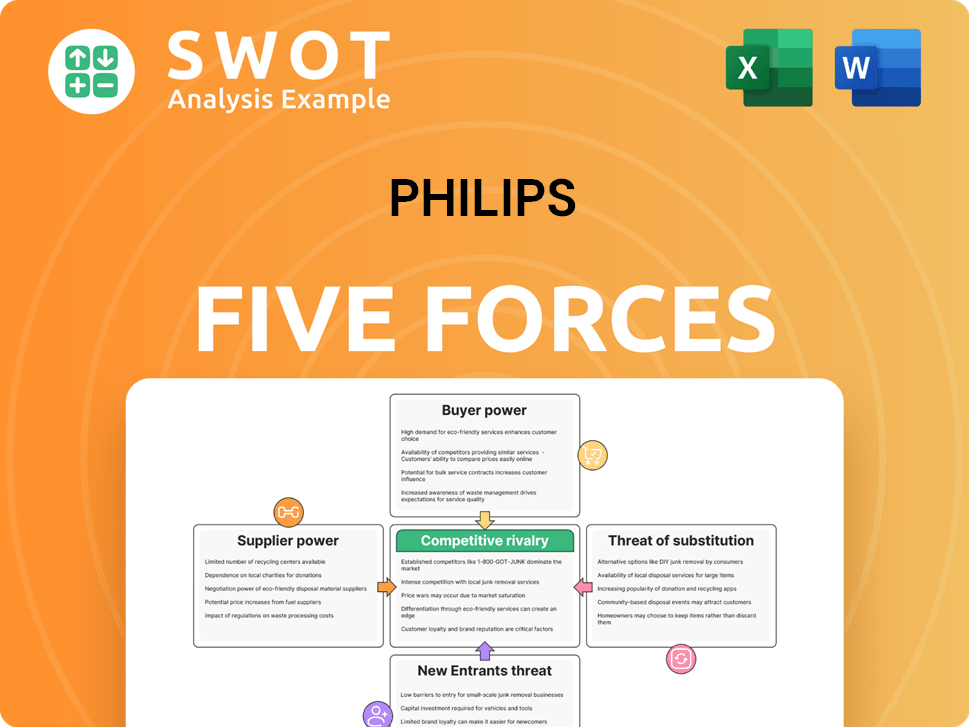
Related Blogs
- What are Mission Vision & Core Values of Philips Company?
- What is Competitive Landscape of Philips Company?
- What is Growth Strategy and Future Prospects of Philips Company?
- What is Sales and Marketing Strategy of Philips Company?
- What is Brief History of Philips Company?
- Who Owns Philips Company?
- What is Customer Demographics and Target Market of Philips Company?
Disclaimer
All information, articles, and product details provided on this website are for general informational and educational purposes only. We do not claim any ownership over, nor do we intend to infringe upon, any trademarks, copyrights, logos, brand names, or other intellectual property mentioned or depicted on this site. Such intellectual property remains the property of its respective owners, and any references here are made solely for identification or informational purposes, without implying any affiliation, endorsement, or partnership.
We make no representations or warranties, express or implied, regarding the accuracy, completeness, or suitability of any content or products presented. Nothing on this website should be construed as legal, tax, investment, financial, medical, or other professional advice. In addition, no part of this site—including articles or product references—constitutes a solicitation, recommendation, endorsement, advertisement, or offer to buy or sell any securities, franchises, or other financial instruments, particularly in jurisdictions where such activity would be unlawful.
All content is of a general nature and may not address the specific circumstances of any individual or entity. It is not a substitute for professional advice or services. Any actions you take based on the information provided here are strictly at your own risk. You accept full responsibility for any decisions or outcomes arising from your use of this website and agree to release us from any liability in connection with your use of, or reliance upon, the content or products found herein.